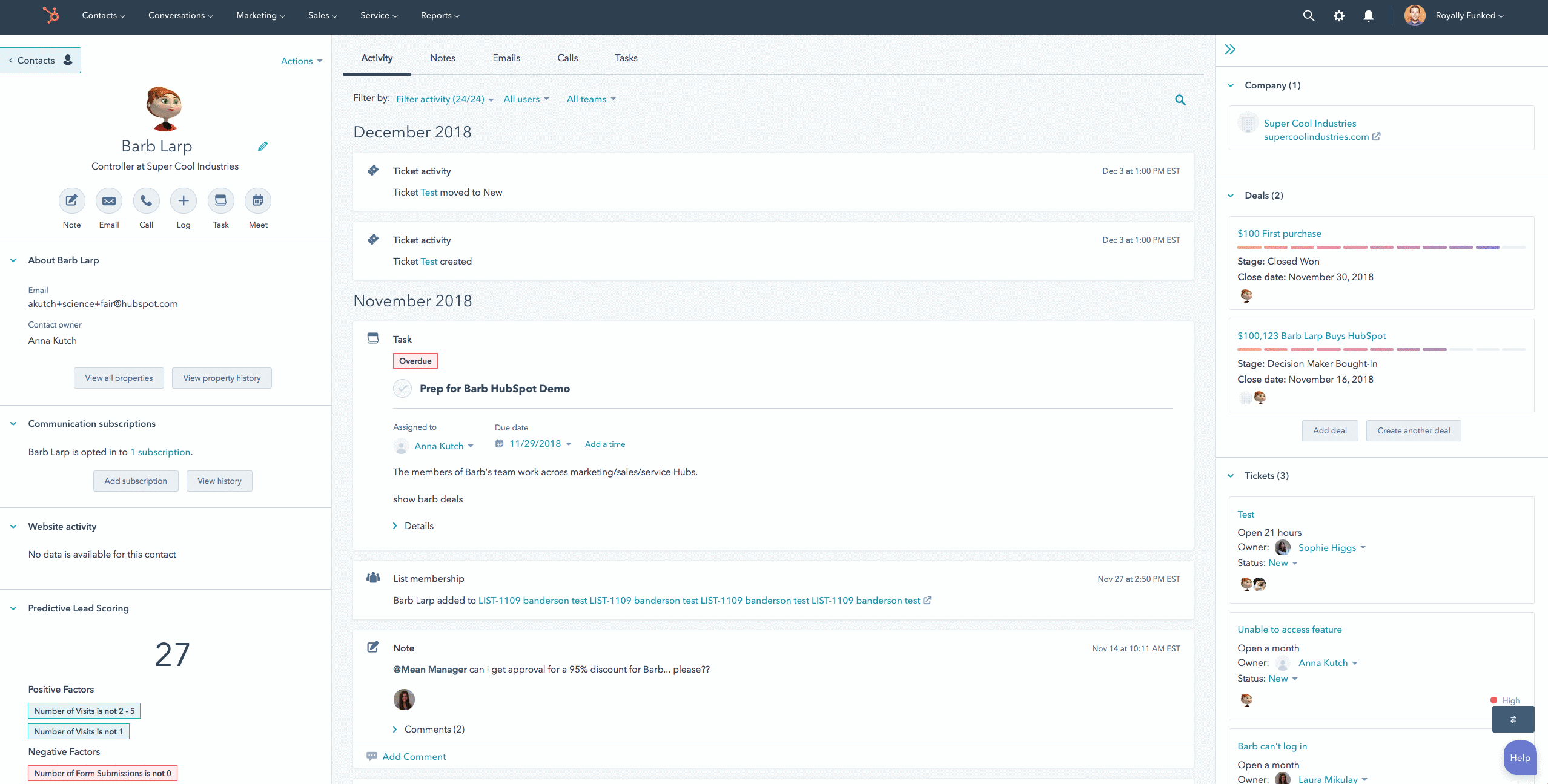Upgrading to a CRM: 8 Best Practices You Need to Know
If you’re implementing a new CRM, here’s how to do it right the first time.
Nearly every business collects the contact information of its leads and customers, but what you do with that information can be the difference between middling sales and booming success. How and where you store your contact information can make a huge difference in what you are able to do with the data you collect.
Are you ready to take your marketing and sales tactics beyond the basic mailing list? You’re going to need a scalable, flexible solution for storing, sorting, and tracking the activity of your contacts. If you’re struggling with trying to maintain your contacts in a Rolodex, spreadsheet, or through your email inbox address book, it’s definitely time to implement a CRM.
What is a CRM?
A customer relationship management software solution, known as a CRM, is a tool used to organize your contact info and manage your relationship with current and prospective customers, clients, and other contacts. There are a TON of CRM providers — at Denamico, we specialize in using the Hubspot CRM — but all of them provide a digital space to hold your contacts and track your interactions.

The Benefits of Implementing a CRM
With a CRM, not only will you be able to store more information than just a Google Contact record or line in a spreadsheet, but you’ll also be able to see the big picture view of your leads and customers’ activities. You’ll be able to identify trends and make decisions based on actual data rather than gut feeling alone.
A digital record of your customers will also allow you to sort them into targeted groups for marketing purposes. Whether you are interested in doing a mailing to a specific geographical area or sending an email to a specific interest segment of customers, you can create lists based on any property you collect information about.
The best CRMs will integrate with your existing systems to streamline and automate your business processes, making sure that none of your potential customers slip through the cracks. And, there's no need to have someone replying to every single incoming lead — the CRM will collect the lead’s information and automate a follow-up email, nurturing the relationship with the customer automatically. With a small amount of set up, you’ll reduce your daily maintenance work significantly and eliminate friction for the customer.
So, if you’ve decided to jump in to a CRM, whether this is all new or you're trying to revive your old CRM system, here are our top tips to ensure that your implementation goes smoothly.
8 Tips for Implementing a CRM
1. Senior leadership should be a champion for the change
While your CEO is likely not going to be using a CRM system on a daily basis, it’s crucial to get the support of the corner office to ensure the success of your implementation.
A CRM Landmark study states that “The greatest likelihood for success is found among companies that see CRM as ‘critical’ or ‘strategic.’ Affording CRM a lesser level of importance, the study says, ‘actually detracts from success because it sends the message to employees and middle management that CRM is not a priority.’"
The trickle down effect is real. If your senior management is committed to and excited about your new CRM system, you are more likely to succeed in company-wide adoption and consistent use.

2. Get buy-in from the end users by involving them in the decision and rollout process
Despite its strategic purpose, any new tool can appear to be an unwanted shake-up if the end users are not consulted. In order to avoid being perceived as a burden, allow your end users to voice their opinion on which CRM system you choose and provide insight as it is being set up. If the end users feel as if this change is being forced upon them, none of them are going to maintain it or use it to its full potential.
You will experience less resistance when you are more transparent about the transition to a new CRM. As you progress through the implementation process, take the time to explain what stage your business is at in the transition, what employees can expect in the next phase, and how they can prepare for the change.
3. Define first, implement second
It’s a common mistake: You get so excited about the possibilities of a new CRM that you create properties and set up operations processes without even stopping to consider your existing systems. This can leave your system jumbled and your staff confused. Instead, begin by mapping out all of the established terms and core processes that your team uses which will now be handled in the CRM. By keeping your departments’ established naming conventions and process stages, your employees will be more likely to embrace the change and quickly adjust to working in the system on a regular basis.
As you assemble the CRM system, it is essential to establish internal usage guidelines. If everyone who uses the CRM sets up their own properties instead of using the established company-wide values, you’ll end up with a system that’s cluttered and not useful to anyone. To prevent this from happening, you can assign one member of each department to act as a “super user” who can act as a gatekeeper to identify potential duplicate properties and run proposed adjustments past the system administrators.
4. Clean up your import
For better or worse, your CRM system is only as good as the data you put into it, so it’s essential to clean up your data before you upload it to the system. A fragmented import will lead to a CRM that is disorganized and difficult to use.
A clean CRM is essential to ensuring that none of your contacts slip through the cracks. Your CRM will be most useful if you keep the values in a property all in one format. For example, you should make sure that all of your contacts’ addresses include their home state in a single format – either spelled out (Minnesota) or abbreviated (MN) – so that it will be easier to pull and sort your mailing lists.
Names are especially tricky to manage. A standard way to organize names is to have separate properties for first and last names, but some organizations may need additional name categories on record like title or informal address for mailings or nametags. No matter how you decide to divide up your properties, the values in a single category should be uniform in format across your contact records so that you can easily filter and search your database.
5. Utilize segmentation
As you collect information about your leads, look for opportunities to further target your messaging and actions. If you have an opportunity to identify your customer’s job title, demographic, or what products they are interested in, take advantage of it.
Use what you know about your leads to build and deliver content that will appeal to them directly. Using your CRM, you can filter your leads to create segmented lists and send targeted content to potential buyers. As a result of your attention to their individual interests, your customers are more likely to engage with your brand.

6. Use the right tool for the right job
Your new CRM is a powerful tool, but you should take care to leverage its new functionality correctly. Make sure you are using the correct type of property to collect your data in forms.
Whenever possible, avoid using a blank text field to collect information that needs to be in a uniform format for filtering inside your CRM. For example, if you are asking people to input their home state, give them a dropdown bar to select their answer instead of a blank text field so that the submissions are in your established uniform format. Your ultimate goal is to gather information while keeping your data as clean as possible so that you don’t have to clean it up later.
7. Integrate with your other applications
Just because you are using a CRM doesn’t mean you have to give up the rest of your tech stack. As much as you can, make sure your systems are talking to each other. Nobody wants to do manual entry or weekly uploads if they don’t have to.
Integrate your CRM with your other applications using tools like Zapier, piesync, or if you are using the HubSpot CRM, you can use one of the 308 different technology integrations already established across 15 categories, including lead generation, ecommerce, and calling. These tools exist to make your work easier, so let them do the work of communicating with each other whenever possible.

8. Provide adequate training
Frustrated employees might just throw up their hands and refuse to use the CRM if they feel that they did not receive enough training to understand how to use it. Schedule a block of time for your employees to meet and learn the system together. Make sure there is enough time to walk through the software and to answer questions.
Depending on how quickly your employees pick up the system, you might want to have a second training and additional training sessions throughout the next year for those who need a review or have just joined the company. Additionally, you can assign and train an adept employee from each department to act as a “super user” to provide hands-on advice and on-the-spot answers for the rest of the department throughout the onboarding process and beyond.
Big changes are worth it
There are many reasons to implement a CRM, but ultimately, having a digital record of your customers that is integrated with your existing systems will streamline and automate your business processes while making it easy to nurture your customer relationships. You might experience some resistance, but by using the tips above you can be sure that you’re setting up your CRM the right way the first time!


